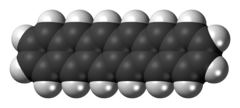Hexacene
Hexacene is an aromatic molecule consisting of six linearly-fused benzene rings. It is one of a series of linear polycyclic molecules created by such aromatic ring fusions, a series termed acenes—the previous in the series being pentacene (with five fused rings) and the next being heptacene (with seven). The CAS registry number for hexacene is , and it has a molecular weight of 328 g/mol. It and other acenes and their derivatives have been investigated in potential applications related to organic semiconductors.
 | |
| Names | |
|---|---|
| IUPAC name
Hexacene | |
| Identifiers | |
3D model (JSmol) |
|
| ChemSpider | |
PubChem CID |
|
CompTox Dashboard (EPA) |
|
| |
| |
| Properties | |
| C26H16 | |
| Molar mass | 328.41 g/mol |
Except where otherwise noted, data are given for materials in their standard state (at 25 °C [77 °F], 100 kPa). | |
| Infobox references | |
Reactivity
Hexacene is very unstable, being highly reactive in the 6 and 15 positions, due to pi electron localization. Its spectra must be collected on freshly purified samples handled in an inert atmosphere such as nitrogen or argon. Only with very large substituents it is possible to isolate an hexacene for instance the compound 6,15-bis(tri-t-butylsilylethynyl)hexacene, which melts with decomposition at 96 °C.[1]
Syntheses
The first reported synthesis of hexacene dates to 1939.[2][3][4] In 1955, the compound was reportedly synthesized by dehydrogenation of hexacosahydrohexacene by palladium on carbon.[5] In 1982, hexacene was reported to be a bluish green compound that decomposed at 380 °C.[6] In 2007, a research group claimed the first reproducible synthesis of unsubstituted hexacene—purportedly invalidating previous claims—based on photochemical decarbonylation of a diketone precursor:[7]
The compound synthesized could not be isolated: it dimerized at concentrations as low as 10−4 M, and reacted with oxygen in solution to form an organic peroxide. In a poly(methyl methacrylate) polymer matrix such side-reactions were limited, and the compound survived up to 12 hours. The next homologue heptacene also studied by this group, and was even more unstable, decomposing within 4 hours.
The synthesis of hexacene has also been reported to yield a crystalline solid from a monoketone precursor, by solid state synthesis at 180 °C.[8] The solid was reported stable in the dark for up to a month, stability attributed to its "herringbone" crystalline packing that prevented dimerization.[8]
In December 2016, the groups of Diego Peña and Francesca Moresco reported synthesis of hexacene in-situ, via deoxygenation of an air-stable precursor, and used scanning tunneling microscopy to produce orbital resonance images of a single hexacene molecule.[9]
References
- Payne M. M.; Parkin S. R.; Anthony J. E. (2005). "Functionalized higher acenes: hexacene and heptacene". Journal of the American Chemical Society. 127 (22): 8028–9. doi:10.1021/ja051798v. PMID 15926823.
- Marschalk, C. Linear hexacenes. Bull. Soc. Chim. Fr. 6, 1112–1121 (1939).
- Clar, E. Aromatic hydrocarbons. XXIV. Hexacene, a green simple hydrocarbon. Ber. Dtsch. Chem. Ges. B 72B, 1817–1821 (1939).
- E. Clar (1942). "Eine neue Synthese des Hexacens (Aromatische Kohlenwasserstoffe, XXXIV. Mitteil.)". Berichte der deutschen chemischen Gesellschaft. 75 (11): 1283–1287. doi:10.1002/cber.19420751102.
- Bailey, W.J. & Liao, C.W. (1955). "Cyclic Dienes. XI. New Syntheses of Hexacene and Heptacene". J. Am. Chem. Soc. 77 (4): 992–993. doi:10.1021/ja01609a055.CS1 maint: uses authors parameter (link)
- Angliker H.; Rommel E.; Wirz J. (1982). "Electronic spectra of hexacene in solution (ground state, triplet state, dication and dianion)". Chemical Physics Letters. 87 (2): 208–12. Bibcode:1982CPL....87..208A. doi:10.1016/0009-2614(82)83589-6.
- Mondal, R.; Adhikari, R.M.; Shah, B.K. & Neckers, D.C. (2007). "Revisiting the Stability of Hexacenes". Org. Lett. 9 (13): 2505–2508. doi:10.1021/ol0709376. PMID 17516652.CS1 maint: uses authors parameter (link)
- Watanabe, M.; Chang, Y.J.; Liu, S.-W.; Chao, T.-H.; Goto, K.; Islam, M.M.; Yuan, C.H.; Tao, Y.T.; Shinmyozu, T. & Chow, T.J. (2012). "The synthesis, crystal structure and charge-transport properties of hexacene". Nature Chemistry. 4 (7): 574–578. Bibcode:2012NatCh...4..574W. doi:10.1038/nchem.1381. PMID 22717444.CS1 maint: uses authors parameter (link)
- Krüger, Justus; Eisenhut, Frank; Alonso, José M.; Lehmann, Thomas; Guitián, Enrique; Pérez, Dolores; Skidin, Dmitry; Gamaleja, Florian; Ryndyk, Dmitry A.; Joachim, Christian; Peña, Diego; Moresco, Francesca; Cuniberti, Gianaurelio (2017). "Imaging the electronic structure of on-surface generated hexacene". Chem. Commun. 53 (10): 1583–1586. doi:10.1039/C6CC09327B. ISSN 1359-7345. PMID 27990553.
External links
- Molecular graphics representation of the X-ray crystallographic structure determined for 6,15-bis(tri-t-butylsilylethynyl)hexacene—hexacene with bulky, protective substituents in the reactive 6- and 15- ring positions, see rotating graphic at base of page.
- Sander-Wise Polycyclic Aromatic Hydrocarbon Structure Index entry for hexacene, NIST Special Publication 922.
